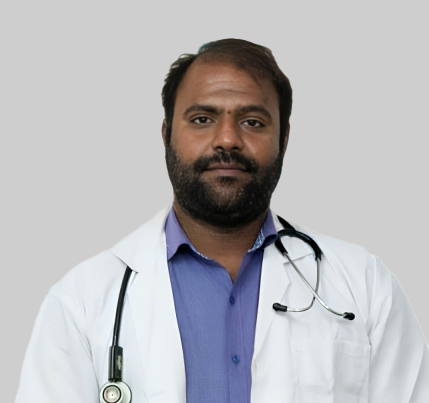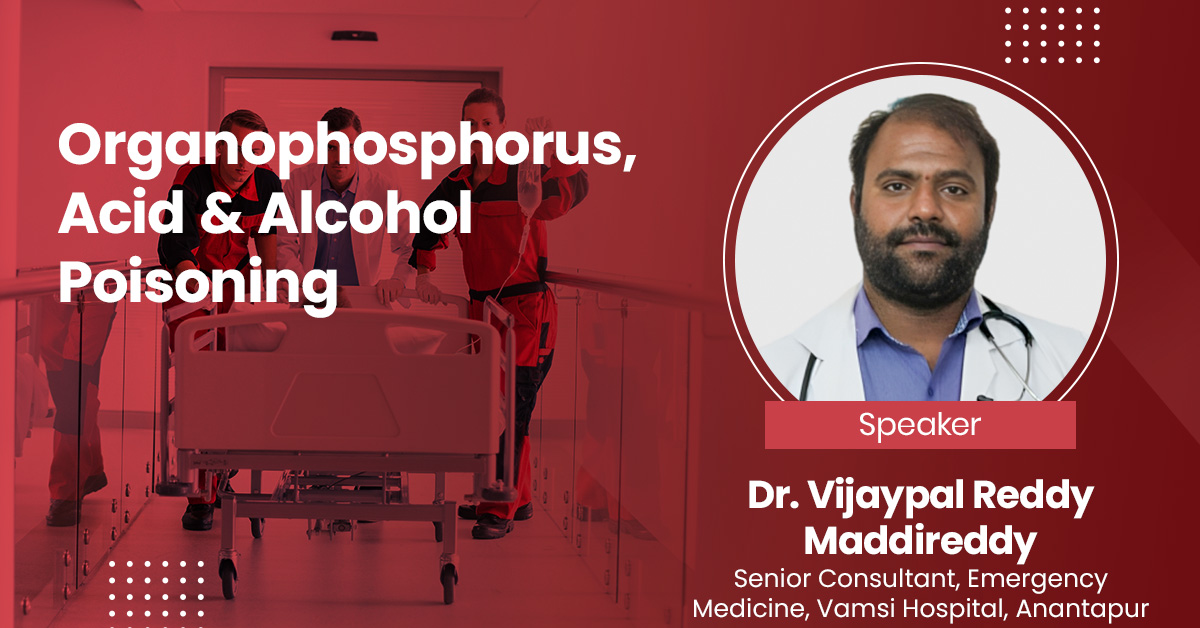- 74k views
Organophosphorus, Acid & Alcohol Poisoning
Organophosphorus, acid, and alcohol poisonings present distinct challenges in medical management. Organophosphorus poisoning, often due to insecticides, requires prompt administration of atropine and pralidoxime to counteract cholinergic toxicity. Acid poisoning necessitates timely neutralization and meticulous airway management to prevent complications like aspiration pneumonia. Alcohol poisoning, marked by central nervous system depression, demands supportive care, including airway protection and fluid resuscitation, while addressing potential co-ingestions. Individualized treatment plans, close monitoring, and collaboration across medical specialties are crucial for optimizing outcomes in cases of these diverse poisonings.
About the Speaker

Dr. Vijaypal Reddy Maddireddy
Senior Consultant Emergency Medicine Vamsi Hospital, Anantapur
Dr. Vijaypal Reddy Maddireddy, a highly accomplished medical professional, has embarked on an impressive journey in the field of emergency medicine. His educational foundation includes a degree from Government Medical College, Anantapur, which laid the groundwork for his illustrious career. Complementing his medical expertise, he pursued postgraduate residency in the Department of Emergency Medicine at Narayana Health City, Bangalore, where he further refined his expertise. He has worked in esteemed hospitals like Dr. YSR Memorial Multispecialty Hospital in Anantapur ,Premier Hospitals in Hyderabad ,KIMS Rainbow Hospitals in Kurnool And Kamineni Hospitals in Hyderabad ,contributing significantly to the field of emergency medicine.
Upcoming Case Discussions
Impact of Endometriosis on Fertility
Endometriosis, a condition where endometrial-like tissue grows outside the uterus, can significantly impact fertility. It causes inflammation, scarring, and adhesions that may distort pelvic anatomy, block fallopian tubes, and impair ovarian function. Endometriosis is also linked to hormonal imbalances and poor egg quality, reducing the chances of conception. Symptoms like chronic pelvic pain and painful intercourse further complicate fertility. Diagnosis often requires laparoscopy, while management includes pain relief, hormonal therapy, and assisted reproductive techniques like IVF. Early intervention with medical or surgical treatment can improve reproductive outcomes, but severe cases may necessitate advanced fertility treatments for conception.
Hyperlipidemia: From Diagnosis to Treatment
Hyperlipidemia is a condition characterized by elevated levels of lipids, such as cholesterol and triglycerides, in the blood, which can increase the risk of cardiovascular diseases. Diagnosis typically involves blood tests measuring lipid profiles, while treatment focuses on lifestyle changes, such as diet and exercise, alongside medications like statins to manage cholesterol levels and reduce cardiovascular risk. Regular monitoring is essential for effective management and prevention of complications.
Acne: Disorders and Treatment Approaches
Acne is a common dermatological condition caused by clogged pores, excess sebum production, bacterial growth, and inflammation. It can manifest as blackheads, whiteheads, papules, pustules, or cysts, often leading to scarring if untreated. Various factors, including hormonal changes, diet, stress, and genetics, influence its severity. Treatment approaches range from topical and oral medications, such as retinoids, antibiotics, and hormonal therapy, to advanced procedures like chemical peels and laser therapy. A personalized skincare regimen, along with lifestyle modifications, plays a crucial role in managing and preventing acne.
Lung Ultrasound in Acute Respiratory Failure
Lung ultrasound has emerged as a vital, non-invasive tool in the rapid assessment of acute respiratory failure. It provides real-time imaging to differentiate conditions like pneumonia, pulmonary edema, pneumothorax, and pleural effusion with high accuracy. Compared to traditional chest X-rays, lung ultrasound offers superior sensitivity, especially in critically ill patients where bedside evaluation is crucial. Its ability to guide immediate clinical decisions improves patient outcomes and reduces unnecessary radiation exposure. With standardized protocols like the BLUE (Bedside Lung Ultrasound in Emergency) protocol, it enhances diagnostic efficiency in emergency and ICU settings.
Gallstone Disease & Cholecystitis: When to Operate?
iGallstone disease and cholecystitis are common conditions requiring careful evaluation to determine the need for surgery. Symptomatic gallstones causing recurrent pain, nausea, or complications like cholecystitis often necessitate cholecystectomy. Acute cholecystitis, characterized by inflammation, fever, and right upper quadrant pain, typically requires early surgical intervention to prevent complications like perforation or sepsis. In high-risk patients, conservative management with antibiotics and drainage may be considered. Elective surgery is recommended for asymptomatic patients with high-risk factors, such as large gallstones or gallbladder polyps, to prevent future complications.







